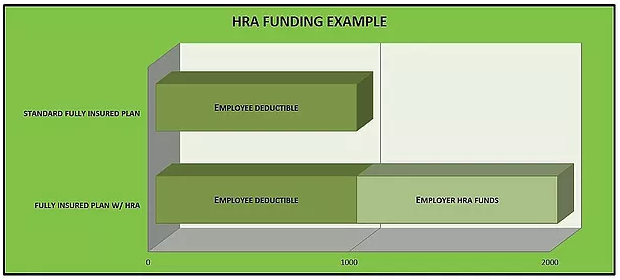HAPPY FRIDAY!!
HRA’S, or Health Reimbursement Accounts, ( NOT TO BE CONFUSED WITH HSA’s ) are one of my favorite strategies to use to help employers save money on their employee health insurance plans. As an employer, you honestly get the best of both worlds with a properly executed HRA – lower monthly premium while offering an equal or better plan to your employees. Here’s how it works.
The image above is one of the documents I created years back to help give employers something visual to look at to understand the concept. Take a look at it or use the pdf document on the employee benefits page on my site to use as a reference point while I explain this:
Using the example above, let’s say that today, you offer your employees a $1,000 deductible plan. Everyone loves the plan and you’re happy because your employees are happy. Things are running smoothly until it happens…..your renewal comes and it was much more than what you had budgeted for. Your agent shopped the market for you and nothing was competitive with your current plan – they negotiated the rates down for you a little, but the increase was still too much. You’re left with only a few options:
1. Keep the same plan and just increase employee contributions
2. Raise the deductible of the plan to lower the premium
3. Drop the plan entirely
Since options 1 and 3 are not something you want to do to your employees, you’re forced to look at decreasing the employees’ benefits to offset the premium increase. This is where the HRA comes in to save the day.
To offset the premium increase, we’ll purchase a higher deductible plan to decrease your monthly premium, but in the HRA scenario, as the employer, you agree to pay the back end of the new higher deductible IF AND ONLY IF the employee has claims that exceed the deductible amount you’ve set for them. So, let’s use the example above:
The employer currently offers a $1,000 deductible plan to the employees
They purchase a $2,000 deductible plan to lower their monthly premiums
Through an HRA, the employer agrees to pay the back $1,000 of the new $2,000 deductible
The employee still has their $1,000 deductible plan
The employer only pays a portion of the deductible IF AND ONLY IF the employee has claims that exceed their $1,000 deductible
This is a win-win scenario. The employer gets to enjoy lower monthly premiums while the employee is able to keep the same plan.
In most health insurance plans, half of the employees that have the insurance don’t even use it, and only about half of the ones that do satisfy some part of their deductible. Out of those employees, how many are truly going to exceed that $1,000 deductible? Probably not many – so, the potential additional financial risk an employer is taking on can be very minimal. Setting up the actual HRA itself is a breeze and it requires very little administration on the part of the employer.
All in all, this is a great way to lower premiums and help employees maintain their benefits!
If you have any questions on this, feel free to call or email me – I’m always happy to help!
Have a great weekend and GO BUCKS!!!
Joe
[email protected]
(614) 870.1775
www.bisohio.com

